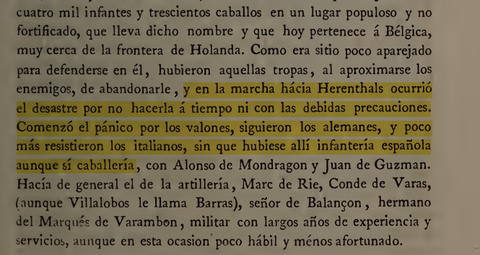秒词邦
分题型分考点背单词 文
文 文
文
原文:
半回旋战术的主要缺点在于遏制了骑兵的冲击力,使其成为一个移动火力平台,但在谈手枪骑兵和枪骑兵优劣时应当明确一点,手枪骑兵的战术≠半回旋。
德勒会战中德意志手枪骑兵痛击敕令靠的是蹲坑打反击而非半回旋
在孔代攻击瑞士人的同时,科利尼的骑兵冲击了蒙莫朗西元帅的其他部队。蒙莫朗西元帅率领骑兵勇敢自信地迎击他们。这一次碰撞是两支骑兵之间的对抗。双方都有重骑兵和轻骑兵,他们列成一排,手持长矛,但新教徒还有黑骑兵。后者庞大的骑兵队伍显然证明了他们在与重装骑士的脆弱对抗中的优势。在这种情况下,骑兵的半回旋并不实用,甚至可能很危险。因此,黑骑兵只是缓慢前进,以保持队形不乱。当他们与天主教的重骑兵保持足够距离时,他们停下来,前两三排进行密集射击。这种射击必然会对重装骑士的薄弱防线造成毁灭性影响。
拉努的评价其实特别有意思,他认为黑骑兵在混战遭遇的危险反而没那么大,因为他们可以在混战中使用手枪破甲。包括他推崇的3步射击,也有研究者认为这种近距离射击在实战中基本等于冲锋后混战使用。
所以也能看得出来,法国人在使用手枪骑的时候还是倾向于与冲击结合起来,而非远距离消耗。而德勒之战中德意志骑兵在对抗敕令则是贴近进行近距离密集弹幕,也不是半回旋。
半回旋只在对付瑞士步兵这种缺少投射的枪阵较为有效(但瑞士人死伤过半任然不崩,以至于中途劝退了胡格诺骑兵),而且孔代还让胡格诺敕令与之一同行动。
圣康坦之战更是难蚌,法军在一系列战术撤退下导致全军崩溃,西班牙骑兵抓住战机,在步兵未就位的情况下就发动冲锋,加速了法军一溃千里
此时军官们争论要不要现在就与法军决战,轻骑兵上尉唐.恩里克.曼里克建议立刻开战,其他人则认为应当等待步兵抵达。然而法军已经被追得七零八落,他们认为整支西班牙军队都在追击他们。唐.恩里克.曼里克发现了这一点,看到步兵正在迅速赶来,立刻带着所有骑兵与法军决战,他们的进攻非常有效,除了法军前锋一部分士兵逃脱外,其余所有人都被俘或被杀。
以至于法国人自己都吐槽“一支两万人的军队被五六千名骑兵驱散并摧毁了一半,这对我们的军队来说太不光彩了。”这很难说是手枪骑兵主导的胜利,更别提啥半回旋战术了。
至于手枪骑兵的另一个成名战蒂伦豪特战役,我之前有写过,和圣康坦一样是组织混乱的产物,而非兵种战术优势的产物。
有哪些在军迷圈广为流传的关于军事的谣言?49 赞同 · 0 评论回答
西班牙在使用火器骑兵时也与法国人一样,希望保住骑兵的冲击力,但和法国人让手枪骑兵进行冲击不同,西班牙人设计了一套手枪—火枪—骑枪三位一体的战术,手枪和火枪骑兵通过火力来扰乱敌阵,以便让枪骑兵冲击破阵,在这里分工更明确化了。
如果我们看奥斯曼骑兵,他们的骑兵也使用手枪/卡宾枪等火器,战术则更接近法国人,近战前仅射击一次随后使用冷兵器进行猛烈的冲锋。
纯粹的半回旋战术在与奥斯曼之类火力+突击的对手作战时效果不佳。1663年8月的战斗中,匈牙利称依赖半回旋的德意志手枪骑兵畏惧近战,甚至在距敌300步的时候就开始无效射击。奥斯曼人的评价倒是更好一些,他们认为手枪骑兵的射击给他们造成了不小的麻烦,但并不能阻碍奥斯曼骑兵对他们发送冲击。
而比起高度依赖火力的德意志骑兵,同样推崇冷兵器突击的匈牙利/克罗地亚骑兵虽然未必能胜利,但在混战中更能取得战果。
而如果把时间倒回长土耳其战争,1600年10月7日,蒂利率领他的胸甲骑兵,顶着奥斯曼步兵的火力攻上的一座山头,夺取了奥斯曼的炮兵阵地。蒂利的胸甲骑兵显然拥有近战的勇气。
而在两天后,蒂利的300名胸甲骑兵与3000名土耳其和鞑靼骑兵相遇,这次轮到鞑靼人施展无效的射击了,鞑靼人满足于从远距离射击,但胸甲骑兵得益于他们的装甲,基本免疫了伤害。此战蒂利的骑兵成功击退了敌人,这战奥斯曼骑兵死了100人,蒂利这边死了10人。
所以手枪骑兵并非一个失败的兵种,比起骑士它的成本更低,更容易训练,也更有纪律性。纯粹依赖火力的半回旋有缺陷,但半回旋仅仅手枪骑兵的一种战术,而非全部。西欧各国很清楚冲击的重要性,无论是法国、西班牙、瑞典还是手枪骑兵大户的德意志,都希望将投射与冲击结合。
最后再提一嘴,以前有骑射传统的摩洛哥人同样使用了半回旋战术,可能是直接从骑射传统演变过来的
与此同时,他开始将侧翼部队沿弧线向两侧推进,开始合围。其次,骑兵会将武器全部射向非斯骑兵的脸部,然后急速左转并进行战斗。第一排将开放第二排向前推进,并向敌人再次齐射——根据理论,敌人现在因噪音和屠杀而陷入恐慌和混乱。
译文:
The main drawback of the half turn tactic is that it suppresses the cavalry's impact, making it a mobile firepower platform. However, when discussing the advantages and disadvantages of pistol cavalry and spear cavalry, it should be clear that the tactics of pistol cavalry are not equal to half turn.
In the Battle of Deleux, German pistol cavalry relied on squatting and counterattacking rather than half turning to fiercely attack the edict
While Kongdai attacked the Swiss, Collini's cavalry attacked Marshal Montmorency's other troops. Marshal Montmorency led his cavalry to bravely and confidently confront them. This collision is a confrontation between two cavalry. Both sides have heavy and light cavalry, who line up with spears, but Protestants still have black cavalry. The latter's large cavalry team clearly proves their advantage in the fragile confrontation with heavy knights. In this situation, the cavalry's half turn is not practical and may even be dangerous. Therefore, the black cavalry only advanced slowly to maintain their formation. When they kept a sufficient distance from the Catholic heavy cavalry, they stopped and engaged in intensive shooting in the first two or three rows. This type of shooting will inevitably have a devastating impact on the weak defense line of heavy knights.
Lanu's evaluation is actually particularly interesting. He believes that the danger faced by black cavalry in melee is not that great, because they can use pistols to break through armor in melee. including his revered three-step shooting, some researchers believe that this type of close range shooting is essentially equivalent to using it in melee after charging in actual combat.
So it can also be seen that the French tend to combine pistol riding with impact rather than long-range consumption. In the Battle of Deleux, the German cavalry engaged in close range dense barrage, rather than half turn, to counter the edict.
Half turn is only more effective in dealing with gun formations lacking projection like Swiss infantry (but more than half of the Swiss casualties still persist, to the point where they dissuade Huguenot cavalry midway), and Conde also ordered Huguenot to act with them.
The Battle of Sant'Artan was even more difficult, as the French army suffered a series of tactical retreats that led to the collapse of the entire army. The Spanish cavalry seized the opportunity to charge without the infantry in place, accelerating the French army's defeat for thousands of miles
At this point, the officers were debating whether to engage in a decisive battle with the French army now. Captain Don Enrique Manrik of the light cavalry suggested starting the war immediately, while others believed that they should wait for the infantry to arrive. However, the French army has been pursued in disarray, and they believe that the entire Spanish army is pursuing them. Don Enrique Manrique noticed this and saw the infantry rushing towards him. He immediately led all the cavalry to a decisive battle with the French army. Their attack was very effective, and except for a portion of the French vanguard who escaped, everyone else was captured or killed.
So that the French themselves roast that "an army of 20000 people was dispersed and destroyed by half of 5000 or 6000 cavalry, which is too disgraceful for our army." It is hard to say that this is a victory dominated by pistol cavalry, let alone the semi swing tactics.
As for the other famous battle of the pistol cavalry, the Battle of Tirenhot, as I have written before, it was a product of organizational chaos, like the Saint Quentin, rather than a product of tactical advantages of the branches.
What are the widely circulated rumors about military affairs in the military fan circle?
49 agree · 0 comment answer
Spain, like the French, also hopes to maintain the impact of their cavalry when using firearms. However, unlike the French who allow pistol cavalry to charge, the Spanish designed a three in one strategy of pistol, musket, and cavalry. Pistol and musket cavalry use firepower to disrupt the enemy's formation, allowing them to charge and break through the formation. The division of labor here is more clear.
If we look at the Ottoman cavalry, their cavalry also used firearms such as pistols/carbines, and their tactics were closer to those of the French, shooting only once before close combat and then using cold weapons for fierce charges.
The pure half turn tactic is not effective when fighting against opponents such as Ottoman firepower and assault. In the battle of August 1663, Hungary claimed that the German pistol cavalry, relying on half turns, feared close combat and even began ineffective shooting at a distance of 300 steps from the enemy. The Ottomans had a better evaluation, as they believed that the shooting of pistol cavalry caused them considerable trouble, but it did not hinder the Ottoman cavalry from launching attacks on them.
Compared to the German cavalry, which heavily relied on firepower, the Hungarian/Croatian cavalry, who also admired cold weapon assault, may not necessarily win, but they are more able to achieve results in melee.
But if the time goes back to the Long Türkiye War, on October 7, 1600, Tilly led his breastplate cavalry to attack a mountain against the fire of Ottoman infantry and seize the Ottoman artillery position. Tilly's breastplate cavalry clearly possesses the courage to engage in close combat.
Two days later, Tilly's 300 cuirassiers met 3000 Türkiye and Tatar cavalries. This time it was Tatar's turn to shoot ineffectively. Tatars were satisfied with shooting from a distance, but cuirassiers benefited from their armor and were basically immune to damage. In this battle, Tilly's cavalry successfully repelled the enemy, with 100 Ottoman cavalry killed and 10 killed on Tilly's side.
So pistol cavalry is not a failed unit, it is cheaper, easier to train, and more disciplined than knights. The semi turn, which relies solely on firepower, has its flaws, but it is only a tactic of pistol cavalry, not the whole. Western European countries are well aware of the importance of impact, and whether it is France, Spain, Sweden, or Germany, which has a large number of pistol cavalry, they all hope to combine projection with impact.
Lastly, let me mention that Moroccans who used to have a tradition of equestrian archery also used a semi roundabout tactic, which may have evolved directly from the tradition of equestrian archery
At the same time, he began to push the flanking troops along an arc towards both sides and began to encircle. Secondly, the cavalry will shoot all their weapons towards the face of the non cavalry, then quickly turn left and engage in battle. The first row will open up and the second row will advance forward, firing at the enemy again - according to theory, the enemy is now in panic and chaos due to noise and slaughter.
句子分析1:
He immediately led all the cavalry to a decisive battle with the French army.
句子成分分析:(划分说明![]() )
)
He immediately led all the cavalry to a decisive battle [with the French army].
句子语法结构详解:
(led 为 lead 的过去式。)
* led 为谓语,采用一般过去时。
* he 为人称代词主格。the 为定冠词。a 为不定冠词。
相关语法知识:
 时态
时态
 all 的用法
all 的用法
 人称代词
人称代词
句子相关词汇解释:
Vocabulary:
| immediately [i'mi:diәtli] | ad. | 1) 立刻; 马上 2) 接近, 紧接, 附近 |
| lead [li:d] | vt. | 1) 带路,引导,带领 2) 处于领先地位,最擅长于 |
| all [ɔ:l] | a. | 1) 所有的, 全部的,一切的 2) 整个的 |
| cavalry ['kævәlri] | n. | (通常作 the cavalry)(旧时的)骑兵,装甲兵 |
| decisive [di'saisiv] | a. | 1) 决定性的,关键的 2) 坚决的,果断的,决断的 |
| battle ['bætl] | n. | 1) 战役,战斗,搏斗 2) 较量,争论,斗争 |
| French [frentʃ] | a. | 1) 法国的 2) 法国人的 |
| army ['ɑ:mi] | n. | 1) 军队 2) 陆军 3) 大批,大群 |
句子语法错误检查:
(未发现错误)
句子分析2:
However, unlike the French who allow pistol cavalry to charge, the Spanish designed a three in one strategy of pistol, musket, and cavalry.
句子成分分析:(划分说明![]() )
)
[However], [unlike the French (who allow pistol cavalry to charge)], the Spanish designed a three [in one strategy (of pistol, musket, and cavalry)].
句子语法结构详解:
* who 为关系代词,引导定语从句。
* allow 为谓语,采用一般现在时。
* to charge 为不定式,作宾语补足语(或称复合宾语)。
* designed 为谓语,采用一般过去时。
* the 为定冠词。a 为不定冠词。
相关语法知识:
 定语从句
定语从句
 时态
时态
 复合宾语
复合宾语
 不定式
不定式
 并列连词
并列连词
句子相关词汇解释:
Vocabulary:
| however [hau'evә] | ad. | 1) 然而, 仍然 2) 无论如何,不管怎样, 究竟怎样 3) (与形容词和副词连用) 不管多么 |
| unlike [,ʌn'laik] | prep. | 与...不同, 不像..., 与...相反 |
| French [frentʃ] | n. | 1) 法国人 2) 法语 |
| allow [ә'lau] | vt. | 1) 允许,准许 2) 给予 |
| pistol ['pistl] | n. | 手枪 |
| cavalry ['kævәlri] | n. | (通常作 the cavalry)(旧时的)骑兵,装甲兵 |
| charge [tʃɑ:dʒ] | vi. | 1) 收费,要价 2) 猛攻,猛冲,冲锋 3) 充电 |
| Spanish ['spæniʃ] | n. | 1) 西班牙人 2) 西班牙语 |
| design [di'zain] | vt. | 1) 设计,制图,构思 2) 计划,筹划,制订 |
| three [θri:] | num | 三 |
| one [wʌn] | a. | 1) 一的;一个的;一个人的 2) 单独一个的, 仅仅一个的 |
| strategy ['strætidʒi] | n. | 1) 策略,计划 2) 策划,部署 |
| musket ['mʌskit] | n. | (旧时的)火枪,滑堂枪,毛瑟枪 |
| and [ænd] | conj. | 1) 和, 与, 同, 并 2) 然后,接着 |
句子语法错误检查:
(未发现错误)

以上是秒词邦为您整理编写的文章《为什么东方的铁甲骑射战术称雄数百年,西方的半回旋战术却很快被破解?》的全部内容。秒词邦是国内权威分题型分考点背诵中高考/四六级考研/专升本/出国单词的专业单词软件。扫描如下小程序码,进入秒词邦官方小程序获取更多英语相关资料! 【关键词:高考单词;高考英语;高中单词;高中英语;单词app;单词软件;记单词app;记单词软件;背单词软件;背单词app;英语单词;四六级单词;四六级英语;四六级单词app;四六级单词软件;考研单词app;考研单词软件;核心单词;高考冲刺复习;高考英语教材;高考英语真题;四六级真题;四六级试题;考研真题;考研英语单词;考研英语真题】





